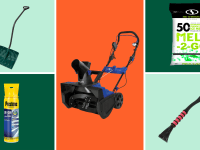7 ways to stay warm when you lose heat in your home
Break out the beanies and blankets
Products are chosen independently by our editors. Purchases made through our links may earn us a commission.
While cold weather can often feel like an inconvenience in a normal setting, it can pose a real threat in emergency situations. If you lose heat, it's crucial to know how to stay warm without heat.
During emergency weather events, the risk of hypothermia is serious. Keeping the house warm and insulated, along with maintaining your body’s heat, are both important for staying safe.
Here is how to stay warm without heat.
1. Avoid opening and closing doors
When a power outage strikes, your main goal is to retain as much heat as possible in your home so you can stay warm without heat.
Opening doors will allow heat to escape or diffuse and dissipate more easily. The National Weather Service recommends closing off rooms to avoid wasting heat. If possible, try to hunker down in one room with the rest of your household. The CDC recommends huddling together with others to retain body heat. Now’s the time to snuggle up to Fido.
2. Close blinds and curtains
During a heatwave covering your windows can help keep heat out. So when it comes to how to stay warm without heat, you should keep your curtains closed to prevent heat from leeching out through the glass.
Keep all your windows completely covered by closing curtains and blinds during the evening hours. However, when the sun is shining, homeowners should open their blinds and curtains to allow natural heat to come through.
3. Seal up your doors
Similar to the rationale above, keeping doors closed and sealing up the gap at the bottom can staunch heat from leaking out of a room. Use any towels or rags you have around the house and begin rolling them up into a long, tight barrier. Place it up against the bottom crack of the door firmly and keep it there for as long as you need. There are also door draft blockers, like this one from Maxtid made specifically for this purpose (in non-emergency situations they can still help insulate heat to reduce your utility bill).
4. Bundle up
When figuring out how to stay warm without heat, it may seem obvious to bundle up in blankets and winter clothing, but it really is that essential in maintaining a safe internal body temperature.
Make sure to focus on wearing multiple layers—the National Weather Service says these layers should be loose-fitting, lightweight, and warm to wear. Materials with inner layers like wool and silk hold body heat better than cotton does, according to Mayo Clinic. Pendelton blankets are made from 100% wool and will be an important layer of insulation for your family.
To further protect your body from cold weather, Mayo Clinic also recommends wearing a hat or other protective coverings—this will help prevent heat from escaping from your head, face, and neck area. If you can, use mittens instead of gloves to cover your hands.
If you want to have your fingers free, the ViGrace convertible mittens are a happy compromise to stay warm.
5. Eat right and stay hydrated
When facing cold temperatures with no heat supply, it’s vital to take care of your body, too. Continue to eat and drink as normal, ensuring you are staying properly hydrated. You can also try to eat warm foods and liquids like soup to heat up your body.
While you may be tempted to reach for a cup of warm coffee or a glass of wine, it’s best to avoid caffeine and alcohol altogether. Both stimulants and depressants can cause your body to lose heat, which can put you in a much worse situation. Instead, drink hot water or caffeine-free tea.
6. Avoid using your oven as a heat source
Even after all these steps of how to stay warm without heat, you will most likely still feel cold, especially if the temperature continues to drop throughout the day or night.
However, under no circumstance should you use an appliance, such as your stove or oven, to provide heat to your home. A gas oven can present a dangerous carbon monoxide threat that could lead to poisoning or even death from the colorless, odorless gas.
And while an electric oven doesn’t pose the same kind of danger, it's still a fire hazard. Leaving an electric oven to radiate heat can melt plastics or catch nearby flammable items, like dishcloths, on fire.
7. Know hypothermia when you see it
If temperatures drop to dangerously low levels, hypothermia is a real risk. Be aware of the signs of hypothermia to ensure you can spot it early and act quickly.
While anyone can experience hypothermia, elders and babies are among the groups of people especially vulnerable. According to the CDC, common symptoms of hypothermia in adults include shivering, memory loss, slurred speech, exhaustion, and more. Babies may exhibit symptoms like bright red, cold skin and low energy.
If you or someone in your home is experiencing these symptoms, seek medical help immediately if possible. If you have to wait on emergency services, the CDC recommends continuing to bundle up, using skin-to-skin contact under loose, dry layers, or drinking something caffeine-free and warm to help increase body temperature.


